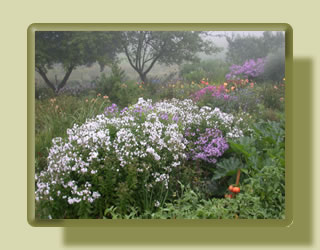|
GENERAL JAPANESE IRIS
INFORMATION
While we have several varieties of Tall Bearded and Siberian Iris,
it is the Japanese iris that has captured our fancy the most. This
variety of iris begins to bloom at a time when the early bulbs and
azaleas are finished, and the daylilies have not yet begun. The bloom of a Japanese iris is frequently
6-8 inches, but can be as large as dinner plates. In addition to
the species plant, they come in single, double and multi forms.
The singles have 3 falls, doubles have 6 falls, and a multi will have 9-12 falls. Japanese
iris will grow well in most perennial gardens, although they prefer
full sun, and a heavy soil rich in organic matter. Japanese iris
which get the needed nutrients and water will respond with a marked
increased height, bud count, branching and overall flower quality.
Manure and peat are both good soil additives for increasing the
amount of organic matter. The iris prefers a slightly acidic soil, with an ideal pH of 5.0 - 6.5. Yellowing of the leaves may
indicate a pH which is too high. If needed, lower the pH by adding
agricultural sulfur or ferrous sulfate. Japanese iris do require
ample moisture, but at 1 inch per week, that is within the norm of many garden perennials. They also
do very well in much wetter areas, such as along the edge of a pond
or beside a stream.
Planting:
When planting Japanese iris, it is recommended that you plant strong
2 - 3 fan divisions. Smaller divisions will take longer to mature,
and are more likely to have problems getting established. Do not
allow the roots to dry out when planting. If you purchase bare rooted plants, it is very beneficial
to soak them overnight prior to transplanting. The iris rhizomes
should be planted 1 - 3 inches deep, and in a depression 3 - 4 inches
deep. This will not only catch and retain moisture, but it will also allow for a longer period
of time before the plant will need to be dug and divided. (The roots
form from the top, over the older roots, and will eventually fill
in the depression.) DO NOT FERTILIZE UNTIL AFTER THE FIRST YEAR.
We use a 2 - 3 inch layer of mulch around the newly planted cultivars.
This will help to reduce weeds, and also help maintain a more stable
soil temperature and moisture level.
Transplanting:
When transplanting Japanese iris, the best time is shortly after
the bloom period. This will give the plant ample time to develop
new roots which will be responsible for the following years improved
bloom. In Vermont, we don't generally have to worry about high temperatures, but if you are
in a warmer region, you may want to delay your transplanting to
a time and place that would be less stressful to the plant.
Fertilizing:
Do Not Fertilize the first year. After that time, a liberal application
of a balanced fertilizer such as 10-10-10 or 12-12-12 is recommended
in spring and again just before blooming.
Pests:
Iris borers and thrips can prey on the iris, but the use of systemic
insecticides can greatly reduce or eliminate any damage they may
cause.
|














